Hornindal: interviews and collecting kveik
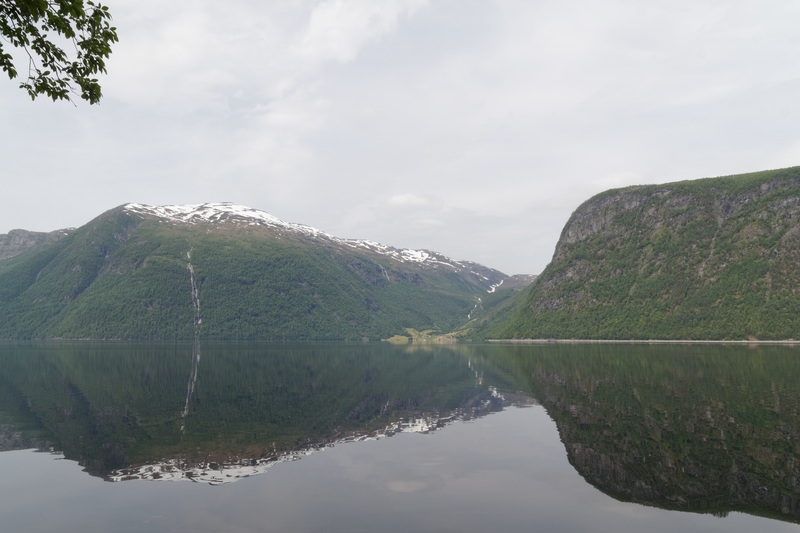
Otterdalen |
Terje learned to brew from his uncle when he was 16, while helping him on the farm during the summer. While we were waiting for the beer to finish fermenting, we drove off to Hornindal to meet him. His uncle lives in the tiny valley you see in the photo above. It's essentially a small notch in the sheer cliffs along the north side of the lake (Hornindalsvatnet). The only inhabitants there now are Terje's uncle, Rasmus, and another family.
Rasmus meets us in his living room, a small spare man in his 80s, with a single bright blue eye. He lost the other in an accident in his youth. He tells me he learned to brew at the age of 12, from his grandmother. This was in 1941, during the war, while Norway was occupied by Nazi Germany. They grew barley on the farm, "every place we could."
They made their own malts, he says. He then repeats the old rule of thumb, used all over Norway: "three days in the brook, three days in the sack". So three days of soaking, then three days of sprouting. He'd spread the grain in a layer about 10 cm thick inside the sacks, and wet the sacks so the grain would stay wet. Then they'd dry the green malts in the sun.
I always wondered about this. It would take almost a week from you started malting before you could dry the malts, and Western Norway is not exactly famous for sunshine. How could you know there would be sunshine a week later? I ask Rasmus, and he just laughs. If the weather was bad they'd just dry it on the floor in the loft. My supposedly thorny problem dissolves in a puff of farmhand practicality. As it so often does.
But Terje brewed from 50% pilsner malts, probably similar in colour to sun-dried malts, and 50% pale malts, which is darker. So why the darker malts, I ask. Well, says Rasmus, if the malts didn't dry properly in the sun he'd dry them a little extra in the kitchen stove. Sometimes he'd bake the malts in there anyway to give it a little extra colour. So the malt bill is probably about the same as it used to be, at least as far as colour goes.
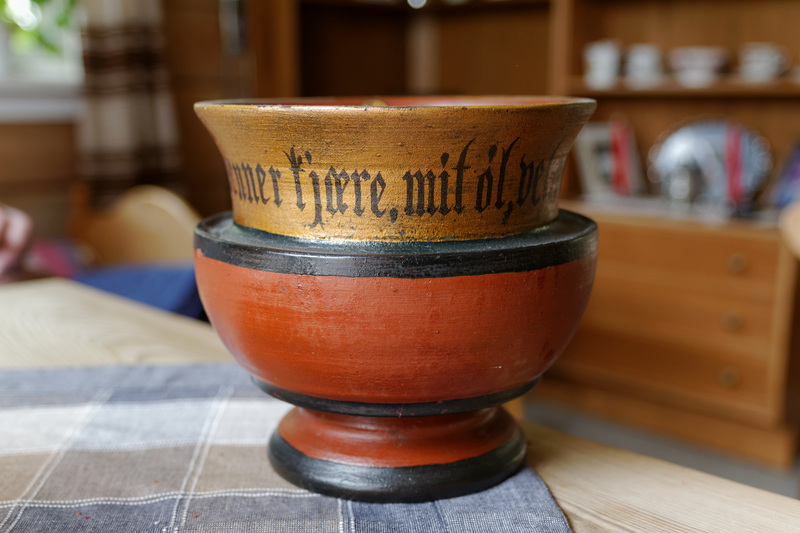
Beer bowl, repainted 1931, but it's older |
"We brewed from the light grain [lettekonnjet]," Rasmus says. I guess this needs some explanation. In the old days, before the time of purebred genetically identical seed grain, people sorted the grain, setting aside the heaviest grain for seed grain, and for brewing. The lighter grain would be used for bread, and, if there was enough, for animal fodder. But Rasmus is saying they used the light grain for beer.
"Why," I ask. He shrugs and says, "we couldn't afford anything else." Which figures. 1941 was not exactly a year of plenty in wartime Norway. I remember my grandmother saying my father as a baby, in 1945, ate ashes in the fireplace because he was so hungry, and the ashes contained fat. So brewing from the heavy grain would have been too extravagant, I guess. But people still brewed.
We discover that Rasmus actually brews in a slightly different way from Terje. Rasmus boils the hops in part of the wort. He calls this "to boil humlebeit" (å koke humlebeit). Again, note how detailed the dialect vocabulary for brewing is. Rasmus says he thought everyone did it this way. It turns out Terje learned the other approach from the friend he got the kveik from, 20 years ago.
Rasmus tells me about another oddity: sometimes people would use heat to bring out the flavour and carbonation in the beer. They'd put a small pan on the stove and heat it up. Then they'd take it off the heat, and pour the beer into it. The beer would then foam up and make a fizzing sound. It's called to "belje" the beer (å belje ølet). Some people say "brøle" instead. Again, note the richness of the vocabulary. Both terms, by the way, mean to shout or roar.
Rasmus hasn't brewed much lately, however, because the last years they've had problems with sour beer. They tried replacing the kveik with new kveik from other brewers several times, but it didn't help. The brewery was in the cellar, and they tried moving it to the barn instead. That didn't help, either. I ask if they used the same brewing kit all along, and Rasmus confirms this. So maybe it was a persistent infection in the fermenter.
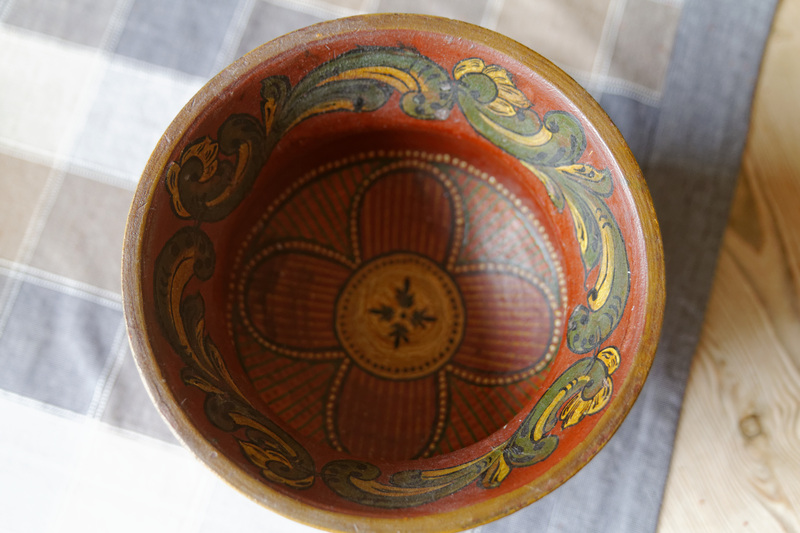
The inside of the bowl |
I had been hoping for another kveik sample, to compare with Terje's kveik, but Terje's brother threw away all the kveik just a few months before my visit. "If I'd known about it, probably I wouldn't have let him," says Rasmus. Terje explains that we wanted to study it genetically, to compare it with other kveik. Rasmus shakes his head, "that was bad."
However, they tell me, the other family in the valley also brew. They've been struggling with sour beer, too, apparently, but maybe we can get a kveik sample anyway. I begin to realize that when people warned me about sour beer in Hornindal, they weren't making it up.
Eventually, the we finish the coffee and the cakes. This, by the way, is characteristic. You cannot visit an older person in Western Norway without being served something, usually coffee and cakes. It's the same with my grandmother. To receive a visitor and not serve something is inconceivable. In earlier days, the something would have been a bowl of beer, of course. The introduction of coffee meant people now had something else to offer guests, and did its part to displace the traditional brewing.
On leaving we drive literally about 100 meters to the next house and stop. Through an open window upstairs we can see a family eating dinner. Terje shouts a greeting up through the window, then explains that I'm researching home brew, and asks if we can have some of their kveik. "No, it's all gone. It went bad, so we threw it away years ago," is the reply. Terje pretends not to have heard. "We just want to study it genetically," he shouts. "We don't care if it makes good beer or not." Silence inside the house, then a brief discussion. "Just a minute," comes the reply.
A few minutes later, the door opens, and a man says "I'll put it in boxes for you. There's three vintages. I'll write the years on the boxes." He does, then gives us the boxes. I ask him if he'd like the kveik back with the bacteria removed. He looks at me. "That's possible?" "Sure," I say, "if bacteria is the problem, the lab can remove them." Yes, he'd like that. We drive off with more kveik than I'd ever expected to see in my life, and I realize I'll have difficulties getting it all into my suitcase.
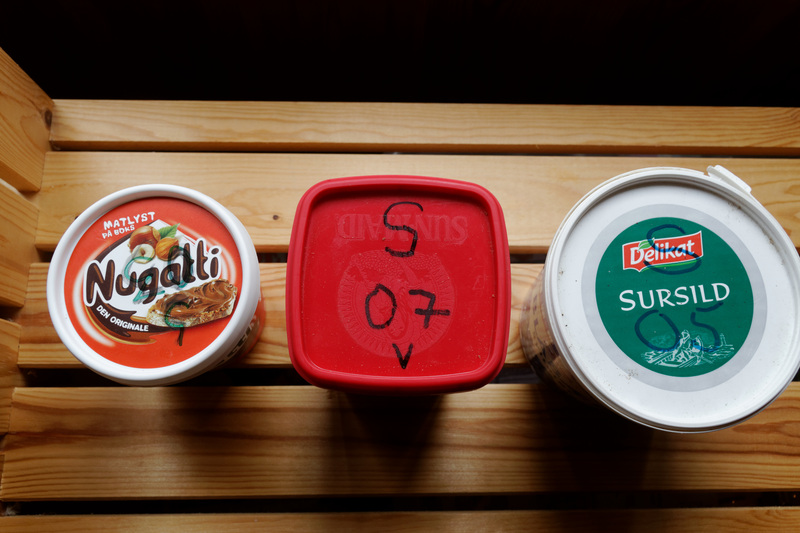
Three boxes of kveik |
From Otterdalen we drive 10 minutes into Hornindal proper and stop at another house. Olav Sverre Gausemel is sitting on his veranda, drinking a can of beer in the July sunshine. He's the guy who gave Terje his kveik 20 years ago. Terje has asked him for a small sample, so we can compare the two cultures and see what, if anything, has changed in 20 years. As we come up onto the veranda Olav Sverre gives me a small plastic bag with some pale brown flakes in it. That's the sample.
He says he was taught that the kveik gets weaker over time. Therefore he's mixed it with kveik from other people, maybe 2-3 times. That kind of ruins the natural experiment I thought I had, but it does mean we might see some new strains. It also explains why Terje's kveik had 8 strains, where some were not related to one another.
I ask him if there's many brewers in the area, and he says pretty much all of them live within a few hundred meters of his house. He starts listing the names. I make it 9. 11 with Terje and him. So while Hornindal is famous for its brewing culture, it does seem kind of threatened. From what I can tell, there's probably at least as many modern brewers as there are traditional brewers.
Eventually, we take our leave and head back to Terje's home in Innvik. There's still 24 hours left before the beer is done fermenting, but this blog post is more than long enough (even though I've left out a number of interesting stories), so we'll end here. Unfortunately, as far as I know, neither NCYC nor NTNU ever got the three boxes of old kveik to grow. So it seems those cultures are dead forever, sadly. Results from the analysis of Olav Sverre's kveik are not in yet.
Update: It seems I confused several people with the kveik that didn't grow. The family stopped brewing because the beer kept going sour, and so those three boxes of kveik were all old. The most recent was from 2007, so that's why the yeast was dead.
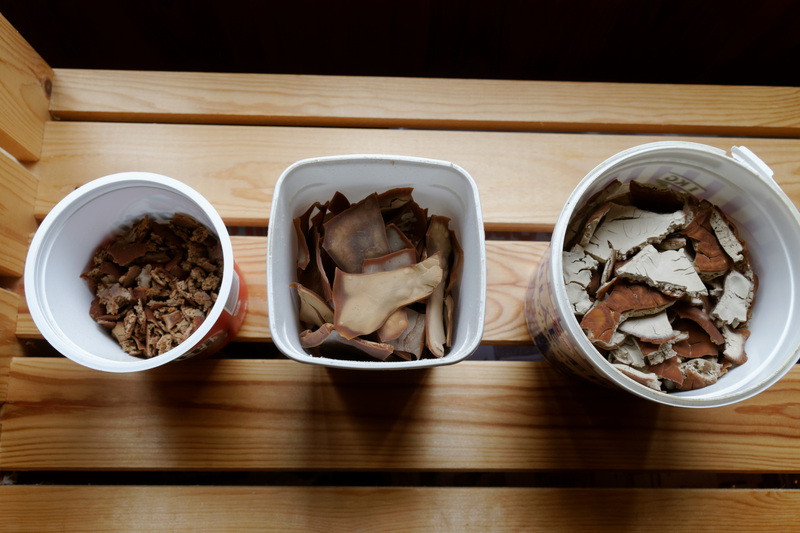
The contents |
Similar posts
Roaring the beer
The first time I heard about it was in Telemark (southern Norway), where Halvor Nordal said that one of his neighbours used to sometimes heat the beer very briefly in a saucepan before serving it
Read | 2018-04-21 22:45
Oppskåke
In older times there were a whole host of detailed social customs around the drinking of beer, but the only one I'm aware of that has survived into the present day is oppskåka
Read | 2016-02-14 12:45
Brewing raw ale in Hornindal
I tried a Hornindal raw ale at a tasting with friends, and was blown away, for two reasons
Read | 2015-12-26 11:35
Comments
Åsmund M. Kvifte - 2016-01-03 19:13:43
It seems to be a recurring problem that kveik samples don't grow (in laboratories). Have you asked the farmers what to do when growth fails, and if they don't know: why isn't it a problem for them?
Lars Marius - 2016-01-04 04:15:02
@Åsmund: There's only been two cases so far of kveik that won't grow, and in both cases it's dried kveik that the brewers had stopped using. If you look at the photo of the boxes you'll see the latest vintage is 2007, so apparently they hadn't brewed in 8 years. So they wouldn't have been able to brew with it, either.
Martynas - 2016-01-10 14:39:44
Another amazing write up, and a thriller at that. Too bad about the dead kveik... it does seem like a race with time to get those remaining living strains studied. I hope you'll do more of that during your next trip you planned with Martin?
Lars Marius - 2016-01-11 05:05:42
@Martynas: Thank you. :) This time we're in Stjørdal, and here they don't have the traditional yeast any more. We found one guy who had it in the 1970s, but nothing after that.
However, I am collecting more strains via various contacts. So I have one from Lærdal, and there seems to be one coming from Hardanger. And Martin Warren collected another interesting one from Voss. So we're making progress still.
Dan ABA - 2016-01-13 18:37:28
This article had many ups and downs for me, Lars. Sorry to hear that the yeast couldn't be revived. Thank you for trying and (hopefully) continuing to try.
Halvor - 2016-01-20 15:09:54
Have you seen this video? Thought it might be interesting. I think the brewer is still alive too.
http://dhs.museum.no/ølbrygging-på-aurlandsvis
Lars Marius - 2016-01-22 08:20:35
@Halvor: Yes, I've seen the video. Very interesting! I've looked up the brewer's phone number. I keep meaning to call him, but haven't got round to it yet. My list of people I should call just keeps growing... :-|
Inger - 2016-04-07 07:33:44
I would think you could still get the kveik that will not grow dna sequenced. They did it to the neanderthal genom, so why not some dead yeast? The deteriorative drift of the proteins in the dna sould be much less in som yeast that have been dead for just ten-fifthteen years as opposed to a neanderthal dead som 30.-10.000 years ago. You would not get live yeast to brew with, but you would at least get a gen sequence which could be comapred to other strains. That would still be interesting I think.
Øyvind Langgård - 2019-10-15 06:01:51
Denne Rasmus i Otterdalen som du besøkte må jo være den samme Rasmus som ga kveiken til John Grodås? De er jo ved ca. samme alder.
Lars Marius Garshol - 2019-10-15 06:10:38
@Øyvind: Nei, faktisk ikke. :) Jeg intervjuet Rasmus Kjøs Otterdal, som regel kjent som "Kjøs-en", mens dette var altså Rasmus O. Otterdal. Han bodde så vidt jeg vet ca 100 meter lenger bort.
Som sagt er det ikke lett å holde styr på innbyggerne i en dal der halvparten heter Rasmus Otterdal.
Tia Larson - 2021-01-05 23:28:01
I was so excited to read this story about my cousin! I just scanned a diary of my great-grandfather, Rasmus Otterdal, who left Otterdal in 1881. The diary is of his journey I think. It is in Norwegian and I wanted to get it to Rasmus. Do you have his email address? I visited Rasmus at Otterdal in 1987 and he was here in Minnesota in 1994. I lost contact and found your article! I will be happy to spend the $180 mailing if I know he is still there but it really makes more sense to email it. Thank you for the interesting article!! Tia
Lars Marius Garshol - 2021-01-06 07:15:27
@Tia: I'm afraid Rasmus is dead now, but his nephew Ståle is currently living in his house. I can try to connect you with Ståle. I'll send you an email.